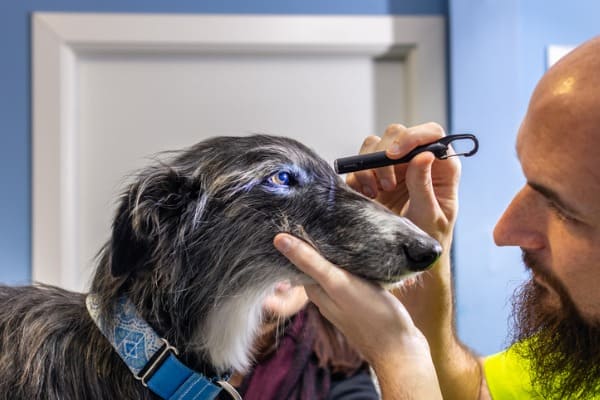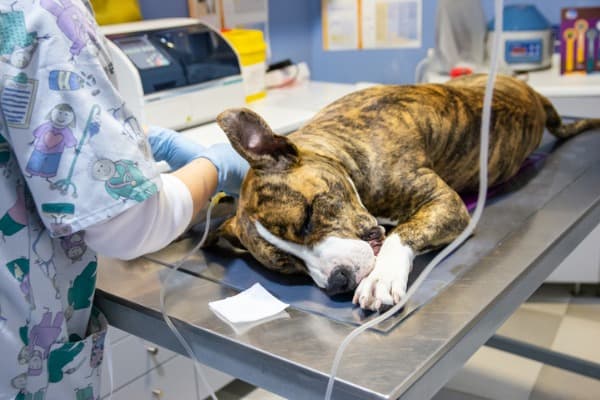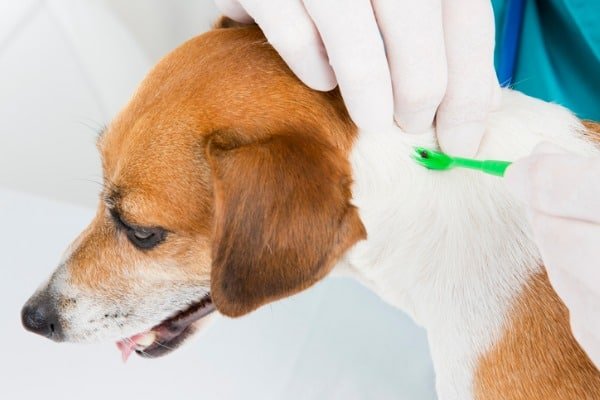Skin tags on a dog can show up just about anywhere on the body.
In some cases:
It’s no big deal – a skin tag is not in itself a health concern for your dog.
What about when a skin tag presents itself in an awkward spot on your dog?
If you notice your dog has a skin tag on their eyelid, that’s understandably concerning.
Although a simple skin tag isn’t a big deal, its location can cause some complications that need to be addressed.
When present on the eyelid:
A skin tag can begin to rub on the surface of your dog’s eye, causing irritation or even vision issues.
What are the options for treating this irritating skin condition?
You should let the vet deal with a skin tag on your dog’s eye, but you can relax – the treatment options are relatively simple and low-risk for your dear dog.
Connect with a verified veterinarian in minutes. No waiting for appointments or office hours. No high fees. Your pet's health made convenient and worry-free.
What is a Skin Tag?

Known scientifically as acrochordon, skin tags are small, malleable bits of flesh protruding from your dog’s dermal layer.
They are usually the same color as the skin and usually aren’t very large.
Sometimes, you’ll find a black skin tag on your dog.
Skin tags are attached to the skin by a “stem” or “stalk” but don’t always extend very far from the surface of the skin.
It might sound gross to you, but odds are you’ll have a few in your lifetime.
Skin tags can affect just about any land mammal and are generally harmless.
In humans:
A skin tag is thought to be caused by skin rubbing against the skin, which makes clusters of collagen and small blood vessels get trapped beneath the upper dermis.
However:
It’s still something of a mystery exactly why they form and why they affect some more than others.
The same goes for skin tags in dogs – rubbing from collars or in folds of the skin can trigger a skin tag formation, but sometimes there is no clear cause.
Older dogs are more likely to experience skin tags, but they can still affect dogs and puppies of all ages.
Dogs with shorter hair might seem to have more skin tags, but this could be due to their short coats making skin conditions more observable.
You can probably narrow down that weird spot on your dog’s skin to a few things, including a skin tag, especially if you’ve seen one before.
Still, it is advisable to have a vet confirm your suspicions in case it’s a more serious issue.
A crucial thing to remember is that a skin tag that changes in color or grows rapidly could actually be a tumor and should be treated by a vet quickly.
While skin tags can start out small and remain small, some will grow as big as a few centimeters in diameter.
A larger skin tag isn’t any more dangerous than a small one, but it has more chance of causing irritation, getting scratched, or torn off.
A skin tag on a dog’s eye can pose some problems regardless of the size, which we’ll cover next.
Keep an Eye on the Puppy Dog Eyes

Next time your dog gives you the classic puppy eyes – while begging for pizza, perhaps – take note.
It’s usually very easy to tell if something is bothering your dog’s eyes.
Most things that irritate your dog’s eyes will cause them to water excessively.
You may also notice your dog’s paws on their face or tries to rub their face on the floor, furniture, or even you.
Redness and swelling are also indicators your dog has an eye issue.
Clean your dog’s eye boogers gently in these cases.
Where do skin tags come into play?
You’ll be relieved to know that a skin tag will not actually sprout out of your dog’s eyeball.
If there’s something on the surface of your dog’s eye, it’s not a skin tag, but something different which needs to be checked on by the vet ASAP.
A skin tag that bothers your dog’s eye is growing out of their eyelid or on the waterline or “rim” of the eyelid.
It can cause discomfort every time they blink or close their eyes by getting caught under the lid, or it can grow to the point that it makes contact with your dog’s eyeball at all times.
Sounds awful, right?
In other places of the body, skin tags are less of a big deal.
On the eye, however, it’s a little more complicated.
An added complication is that skin tags on the eyelid seem to grow faster than on other parts of the body, and no one knows why.
A skin tag interfering with your dog’s eye is enough to cause weepy, crusty, bloodshot eyes.
Plus, there’s a high chance your dog is downright uncomfortable.
If your dog is bothered enough by the skin tag, they might paw and claw at their face until they tear off the skin tag, damage their eye in the attempt, or both.
If left untreated, a skin tag that is rubbing on your dog’s eye can scratch the cornea, cause infections, and damage their vision.
A skin tag on the eye rim of your dog should be removed – but think twice before you attempt to treat this problem at home.
The Case Against DIY
Unless you have veterinary training, we don’t advise trying to remove a skin tag from your dog’s eyelid.
Common home treatments you might come across include apple cider vinegar, tying off the skin tag with floss, or just nipping it off with scissors.
Each of these solutions is risky to try on a skin tag anywhere on your dog’s body because of the risk of bleeding, pain, and infection.
Removing a skin tag near your dog’s eye is even riskier because you can poke or damage their eye.
Most dogs who have a skin tag removed will be anesthetized and sedated by their vet, especially when the skin tag is near a delicate, sensitive spot.
If you can’t remove a skin tag from your dog’s eye at home, then how is the problem dealt with?
Skin Tag Treatment Options
A skin tag on a dog’s eye has removal options that are easy and simple – provided you let the vet take care of it. Let’s look at the most common options.
Option 1

Keep in mind that the vet might suggest a biopsy if the skin tag looks suspicious.
Although having your dog sedated for the procedure might sound serious, it’s a simple surgery that is over in the blink of an eye.
Option 2
Skin tags are usually removed through cauterization, cryotherapy (freezing them off), or cutting.
The first two options might be off of the table when dealing with a skin tag close to your dog’s eye, but a vet can determine if they’re still viable alternatives.
The size and precise location of the skin tag are factors the vet will take into account when deciding how to remove it.
Cryotherapy isn’t an instant fix but instead kills off the tissue, which will die and fall off in a matter of weeks.
It’s an option your vet might suggest if your dog doesn’t react well to anesthesia – a mild sedative is often all that’s needed when using cryotherapy.
This is sometimes the best treatment for an older dog with a skin tag on their eyelid.
Your dog might need to wear an Elizabethan collar – otherwise known as the cone of shame – during recovery.
Pawing at the spot will slow healing and can cause bleeding or infection.
You might have heard that removing skin tags can encourage more to grow or spread. Rest assured, this is not the case.
If your dog develops more skin tags after having one removed, it’s not because you made a choice to get rid of the skin tag.
Remember that some dogs can be prone to getting them, and older dogs especially have a higher chance of getting a skin tag.
Option 3
Another choice the vet might offer you is to leave the skin tag alone for the time being, but that’s only a good option if the skin tag isn’t irritating your dog’s eye.
For example, a skin tag on the bottom eyelid of your dog might be hanging away from your dog’s eye and not affecting them in a negative way.
Sometimes skin tags will dry up and fall off on their own – particularly smaller ones.
Most vets will agree that typical skin tags that don’t bother your dog won’t need to be removed unless it’s for aesthetic purposes.
Preventing Skin Tags on Eyes
Is there a way to keep your dog from growing skin tags on their eye?
Maybe – vets and dermatologists alike don’t know enough about why they form to be sure how effective preventive measures are.
One good thing is that suggested changes to prevent skin tags are good for your dog either way, and they’re not drastic.
1. Banish the Parasites

There are a dozen good reasons to keep your dog on parasite prevention, like anti-flea and anti-tick drops.
Keeping itchy bugs off of their skin can also help avoid a variety of skin ailments.
Excessive rubbing or scratching can be a contributing factor for skin tags, so try to keep your dog free of fleas and ticks.
2. Be Careful With the Bathing
Just like flea bites can cause itching, so can dry or irritated skin.
Nothing will cause these skin issues faster than overbathing or using harsh shampoos on your dog.
Make sure you’re using only dog-safe shampoo, and don’t bathe your dog more than necessary.
When you wash your dog’s face, be extra gentle, and make sure the soap is rinsed clean.
You’ll need to bathe your dog sometimes:
Under bathing can also be problematic and spark some issues in the biome of your dog’s skin.
For most dogs, a bath every four to six weeks is a happy middle ground.
3. Watch Your Dog’s Diet

A poor diet can disrupt your dog’s skin and just about every other system in their body.
Stick with high-quality dog food without too many cheap fillers.
Try to scale back the table scraps and human foods, too.
Some human foods are good for your dog, but fatty, processed, and sugary foods are things that should be shared only on special occasions and in moderation.
Skin Tags Near the Eye – Unwanted Baggage
A skin tag that’s a little too close to your dog’s eye for comfort needs to go.
It can cause eye irritation at best or infections at worst.
And who wants their dog to be uncomfortable with something poking their eye all day?
Don’t be tempted by at-home remedies when it comes to a skin tag on a dog’s eye.
Your intentions may be noble, but you could easily do more harm than good.
Leave it to a vet and their tried-and-tested methods for safely removing a skin tag.
In some cases, a skin tag might be better off left alone for the time being.
Skin tags are easily treated and rarely any cause to panic, so even if your vet advises having it removed, it’s a simple fix for your dog.

